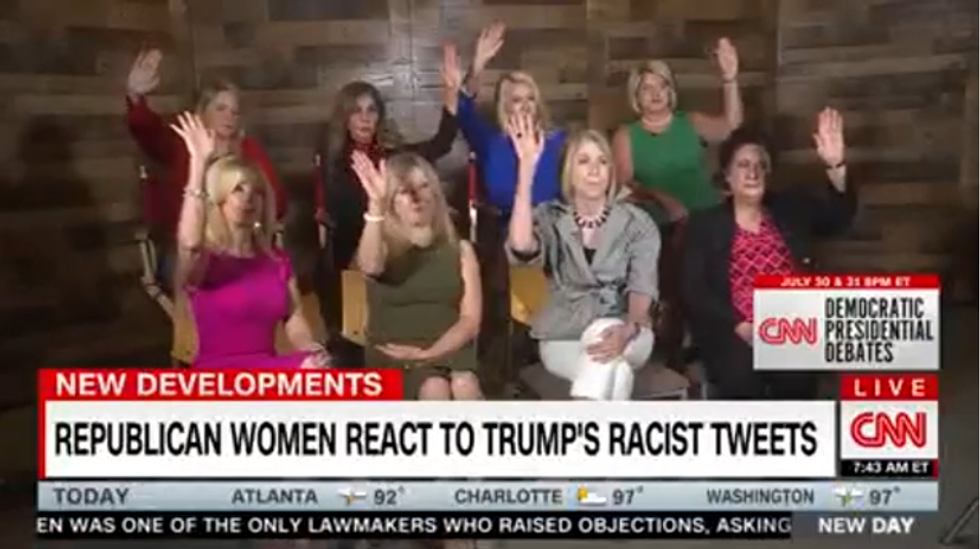
Reuters photo (7/19/19) of a Trump supporter supporting Trump.
Media Can't Quit 'Trump Supporters Support Trump' Stories
It’s hard to escape the conclusion that the point of these person-in-the-street interviews was to give Trump supporters a platform, rather than to take a real look at what "Michigan voters" think
As we hurtle into coverage of a presidential election that is still over a year away, media have returned to their timeworn tradition of going to rural, white communities to take the pulse of the nation (FAIR.org, 5/20/19).
Under the web headline "These Michigan Voters Show How Trump's 'Go Back' Attack May Help Him," the New York Times (7/22/19) ventured to a Trump stronghold in Michigan to bring readers the front-page news that people who supported Trump in 2016 despite his racist attacks still support him despite his racist attacks.

The Times' Stephanie Saul and Jeremy Peters described their look into St. Clair County:
In this overwhelmingly white district an hour north of Detroit, where his popularity remains high, his comments left people in the familiar position of having to choose a side in the aftermath of another Trump-instigated outrage. And they chose his.
The article went on to talk a great deal about the importance of Michigan to the presidential election as a swing state, about counties that had swung from Obama to Trump, and about how close polls are in those counties right now. This would seem to imply that St. Clair County is one of those, where people were more ambivalent about Trump, and therefore informative about which way Michigan might go this time around. But no, St. Clair County went for Romney by 7 points in 2012--and for Trump by 31 points.
Since this fact is disguised, and the "people" in this story seem to be exclusively of a Trumpian persuasion, it's hard to escape the conclusion that the point of these person-in-the-street interviews was to give Trump supporters a platform, rather than to take a real look at what "Michigan voters" think. (Indeed, in Michigan as a whole, Trump's approval rating stands at a net -15, according to Morning Consult polling--down 23 points since January 2017.)
It's a common theme of Trump coverage that now is extending to election coverage: When people protest something Trump does or says, corporate media feel the need to also cover the people who aren't reacting as a sort of faux-balance, giving us tautological Trump-supporters-support-Trump stories.
Reuters (7/19/19) gives us another example this news cycle: "In Battleground Florida, Republicans Shrug Off Trump's Tweet 'Kerfuffle.'" Reporting from Pinellas County, Florida, a Reuters correspondent joined the monthly meeting of a local Republican club--because, as the article explains:
Pinellas is one of four battleground counties that Reuters will report from through the November 2020 election to better understand the states set to play an outsized role in picking the next president.
So why, then, seek out only Republican activists to react to the Trump attacks?
As Reed Richardson pointed out two years ago here at FAIR (2/15/17), this kind of coverage tends to just reinforce right-wing talking points. Case in point from the Times' Michigan story: The paper interviews a local Republican strategist, who comments that the Democratic congresswomen under attack "very much represent the loony left." This quote was then selected by a Times editor to feature in the print edition's subhead--"Michigan Voters Who Worry More About the 'Loony Left'"--twisting a Republican catch phrase into "voter" worries.

At times, the effort required to orchestrate these false-balance stories becomes embarrassingly apparent, as when CNN on July 16 and 17 aired a widely criticized segment that presented a panel of, in the words of CNN reporter Randi Kaye, "eight Republican women from Dallas [who] don't see anything wrong with President Trump telling four Democratic congresswomen to go back where they came from." Sharp-eyed viewers quickly pointed out that these apparently randomly selected Republican women were actually dedicated Trump activists--members of a group called Trumpettes for America who had appeared multiple times on CNN in the past, likewise identified only as Republican women.
CNN's response? It ran the segment again--for the fifth time--this time with a brief nod to the women's group affiliations. Meanwhile, the underlying premise of the segment--that viewers need to hear (five times, no less) that Republicans who have supported Trump through his racist, xenophobic campaign and his racist, xenophobic administration continue to support him after his latest tirade--remains unquestioned by most media.
An Urgent Message From Our Co-Founder
Dear Common Dreams reader, The U.S. is on a fast track to authoritarianism like nothing I've ever seen. Meanwhile, corporate news outlets are utterly capitulating to Trump, twisting their coverage to avoid drawing his ire while lining up to stuff cash in his pockets. That's why I believe that Common Dreams is doing the best and most consequential reporting that we've ever done. Our small but mighty team is a progressive reporting powerhouse, covering the news every day that the corporate media never will. Our mission has always been simple: To inform. To inspire. And to ignite change for the common good. Now here's the key piece that I want all our readers to understand: None of this would be possible without your financial support. That's not just some fundraising cliche. It's the absolute and literal truth. We don't accept corporate advertising and never will. We don't have a paywall because we don't think people should be blocked from critical news based on their ability to pay. Everything we do is funded by the donations of readers like you. Will you donate now to help power the nonprofit, independent reporting of Common Dreams? Thank you for being a vital member of our community. Together, we can keep independent journalism alive when it’s needed most. - Craig Brown, Co-founder |
As we hurtle into coverage of a presidential election that is still over a year away, media have returned to their timeworn tradition of going to rural, white communities to take the pulse of the nation (FAIR.org, 5/20/19).
Under the web headline "These Michigan Voters Show How Trump's 'Go Back' Attack May Help Him," the New York Times (7/22/19) ventured to a Trump stronghold in Michigan to bring readers the front-page news that people who supported Trump in 2016 despite his racist attacks still support him despite his racist attacks.

The Times' Stephanie Saul and Jeremy Peters described their look into St. Clair County:
In this overwhelmingly white district an hour north of Detroit, where his popularity remains high, his comments left people in the familiar position of having to choose a side in the aftermath of another Trump-instigated outrage. And they chose his.
The article went on to talk a great deal about the importance of Michigan to the presidential election as a swing state, about counties that had swung from Obama to Trump, and about how close polls are in those counties right now. This would seem to imply that St. Clair County is one of those, where people were more ambivalent about Trump, and therefore informative about which way Michigan might go this time around. But no, St. Clair County went for Romney by 7 points in 2012--and for Trump by 31 points.
Since this fact is disguised, and the "people" in this story seem to be exclusively of a Trumpian persuasion, it's hard to escape the conclusion that the point of these person-in-the-street interviews was to give Trump supporters a platform, rather than to take a real look at what "Michigan voters" think. (Indeed, in Michigan as a whole, Trump's approval rating stands at a net -15, according to Morning Consult polling--down 23 points since January 2017.)
It's a common theme of Trump coverage that now is extending to election coverage: When people protest something Trump does or says, corporate media feel the need to also cover the people who aren't reacting as a sort of faux-balance, giving us tautological Trump-supporters-support-Trump stories.
Reuters (7/19/19) gives us another example this news cycle: "In Battleground Florida, Republicans Shrug Off Trump's Tweet 'Kerfuffle.'" Reporting from Pinellas County, Florida, a Reuters correspondent joined the monthly meeting of a local Republican club--because, as the article explains:
Pinellas is one of four battleground counties that Reuters will report from through the November 2020 election to better understand the states set to play an outsized role in picking the next president.
So why, then, seek out only Republican activists to react to the Trump attacks?
As Reed Richardson pointed out two years ago here at FAIR (2/15/17), this kind of coverage tends to just reinforce right-wing talking points. Case in point from the Times' Michigan story: The paper interviews a local Republican strategist, who comments that the Democratic congresswomen under attack "very much represent the loony left." This quote was then selected by a Times editor to feature in the print edition's subhead--"Michigan Voters Who Worry More About the 'Loony Left'"--twisting a Republican catch phrase into "voter" worries.

At times, the effort required to orchestrate these false-balance stories becomes embarrassingly apparent, as when CNN on July 16 and 17 aired a widely criticized segment that presented a panel of, in the words of CNN reporter Randi Kaye, "eight Republican women from Dallas [who] don't see anything wrong with President Trump telling four Democratic congresswomen to go back where they came from." Sharp-eyed viewers quickly pointed out that these apparently randomly selected Republican women were actually dedicated Trump activists--members of a group called Trumpettes for America who had appeared multiple times on CNN in the past, likewise identified only as Republican women.
CNN's response? It ran the segment again--for the fifth time--this time with a brief nod to the women's group affiliations. Meanwhile, the underlying premise of the segment--that viewers need to hear (five times, no less) that Republicans who have supported Trump through his racist, xenophobic campaign and his racist, xenophobic administration continue to support him after his latest tirade--remains unquestioned by most media.
As we hurtle into coverage of a presidential election that is still over a year away, media have returned to their timeworn tradition of going to rural, white communities to take the pulse of the nation (FAIR.org, 5/20/19).
Under the web headline "These Michigan Voters Show How Trump's 'Go Back' Attack May Help Him," the New York Times (7/22/19) ventured to a Trump stronghold in Michigan to bring readers the front-page news that people who supported Trump in 2016 despite his racist attacks still support him despite his racist attacks.

The Times' Stephanie Saul and Jeremy Peters described their look into St. Clair County:
In this overwhelmingly white district an hour north of Detroit, where his popularity remains high, his comments left people in the familiar position of having to choose a side in the aftermath of another Trump-instigated outrage. And they chose his.
The article went on to talk a great deal about the importance of Michigan to the presidential election as a swing state, about counties that had swung from Obama to Trump, and about how close polls are in those counties right now. This would seem to imply that St. Clair County is one of those, where people were more ambivalent about Trump, and therefore informative about which way Michigan might go this time around. But no, St. Clair County went for Romney by 7 points in 2012--and for Trump by 31 points.
Since this fact is disguised, and the "people" in this story seem to be exclusively of a Trumpian persuasion, it's hard to escape the conclusion that the point of these person-in-the-street interviews was to give Trump supporters a platform, rather than to take a real look at what "Michigan voters" think. (Indeed, in Michigan as a whole, Trump's approval rating stands at a net -15, according to Morning Consult polling--down 23 points since January 2017.)
It's a common theme of Trump coverage that now is extending to election coverage: When people protest something Trump does or says, corporate media feel the need to also cover the people who aren't reacting as a sort of faux-balance, giving us tautological Trump-supporters-support-Trump stories.
Reuters (7/19/19) gives us another example this news cycle: "In Battleground Florida, Republicans Shrug Off Trump's Tweet 'Kerfuffle.'" Reporting from Pinellas County, Florida, a Reuters correspondent joined the monthly meeting of a local Republican club--because, as the article explains:
Pinellas is one of four battleground counties that Reuters will report from through the November 2020 election to better understand the states set to play an outsized role in picking the next president.
So why, then, seek out only Republican activists to react to the Trump attacks?
As Reed Richardson pointed out two years ago here at FAIR (2/15/17), this kind of coverage tends to just reinforce right-wing talking points. Case in point from the Times' Michigan story: The paper interviews a local Republican strategist, who comments that the Democratic congresswomen under attack "very much represent the loony left." This quote was then selected by a Times editor to feature in the print edition's subhead--"Michigan Voters Who Worry More About the 'Loony Left'"--twisting a Republican catch phrase into "voter" worries.

At times, the effort required to orchestrate these false-balance stories becomes embarrassingly apparent, as when CNN on July 16 and 17 aired a widely criticized segment that presented a panel of, in the words of CNN reporter Randi Kaye, "eight Republican women from Dallas [who] don't see anything wrong with President Trump telling four Democratic congresswomen to go back where they came from." Sharp-eyed viewers quickly pointed out that these apparently randomly selected Republican women were actually dedicated Trump activists--members of a group called Trumpettes for America who had appeared multiple times on CNN in the past, likewise identified only as Republican women.
CNN's response? It ran the segment again--for the fifth time--this time with a brief nod to the women's group affiliations. Meanwhile, the underlying premise of the segment--that viewers need to hear (five times, no less) that Republicans who have supported Trump through his racist, xenophobic campaign and his racist, xenophobic administration continue to support him after his latest tirade--remains unquestioned by most media.

